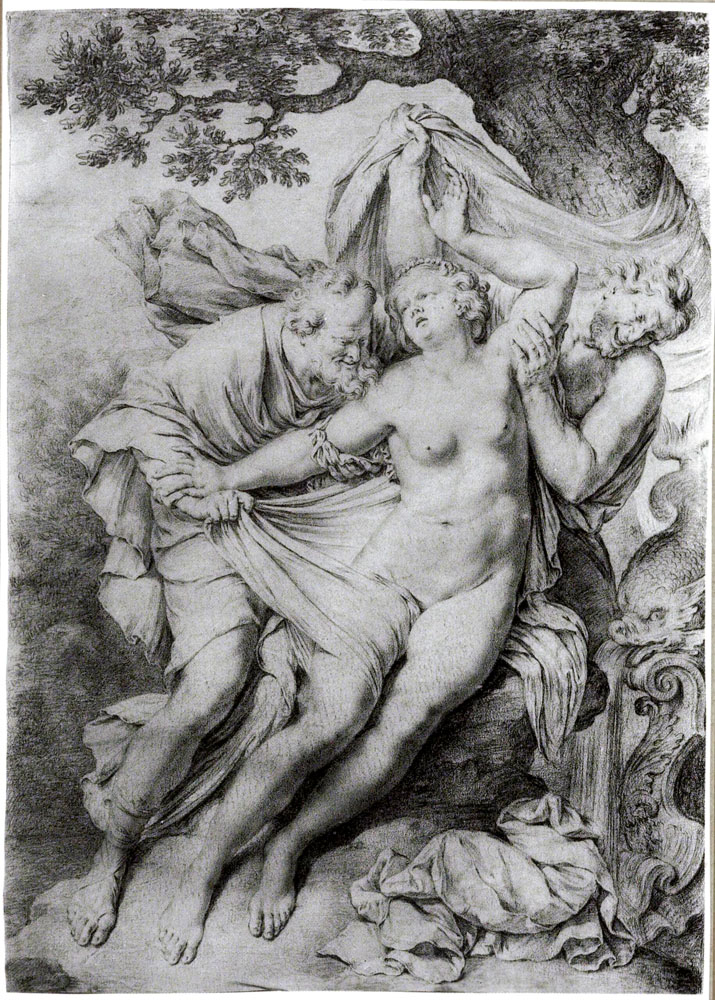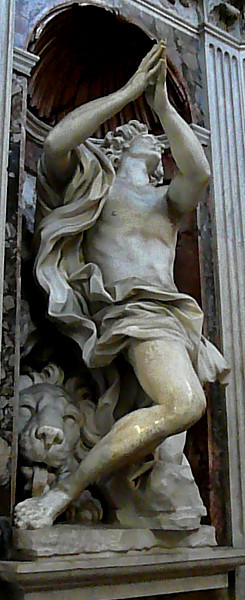Daniel is almost always pictured as a young, beardless person with a full head of hair. In paleo-Christian images of the lions' den his youthful body is shown naked. Jensen ("Nudity," 313-17) relates his nudity to the Roman practice of sending victims into the arena undressed as a way of humiliating them. In the 15th century he sometimes wears one of the "bag hats" fashionable at the time (example). Duchet-Suchaux (113) states that he is sometimes seen in a Phrygian cap because of the Babylonian locale of his story, but so far I have not seen any examples of that type of headwear.
Daniel's sojourn in the lions' den is a particularly popular subject in the sarcophagi of the 4th century. The images of the episode always have him standing in orant position with two lions. Usually the lions sit on either side of Daniel and face him (example), but one sarcophagus has them seated more naturalistically.
In these images we often see Habakkuk bringing bread or stew to Daniel (example), In Vulgate Daniel 14:27-38 an angel carries Habakkuk and the food to Babylon from Judea; some sarcophagi include a second figure who could be an angel, though he has no wings or other indications of such status (example). In one unusual example it is a child who brings the bread to Daniel while two other men stand by approvingly. In another, the prophet is flanked by two men of identical appearance and it is difficult to tell who they are.
The Habakkuk episode continues to be a favored subject in medieval and later art. Wouter Crabeth's Habakkuk and the Angel (1565) pictures Habakkuk taking his bowl of bread and stew to the reapers, the reapers themselves in the background, and the angel placing his hands on the prophet's shoulders. A 1462 woodcut in Die Vier Historien shows the angel delivering Habakkuk and his bowl to Daniel while Nebuchadnezzar looks on.
A manuscript in the collection of Basel University has a number of illustrations of the Book of Daniel, including the prophet's avoidance of the King's food, his interpretation of Nebuchadnezzar's dream, and Balthazar's feast. In all these images, and in the Bernini at right, Daniel is a beardless youth. But in what appears to be a figure of Daniel in one Croatian fresco he has a forked red beard. That fresco has him holding a banderole with a phrase that has now faded away. The beard and banderole reference Daniel's role as a prophet, as we see in Fra Angelico's Crucifixion, which includes a portrait of Daniel holding a banderole with what medievals took to be a prophecy of the Crucifixion.
As for clothing, paleo-Christian images of Daniel in the lions' den regularly picture him naked. Medieval images in the West dress him in whatever the artists think was appropriate for the courtier of an eastern potentate. Orthodox icons have him in military boots and what Tradigo calls "a short robe, a broad cloak, and a Phrygian hat."1 The latter differs somewhat from the Phrygian caps in early images of the Magi, being topped by a rounded or cube-shaped cloth construction.
Daniel 13:1-60 tells how as a boy the prophet saved the life of a woman falsely accused of adultery. Two elders of the community had approached her in her bath and said if she did not lie with them they would accuse her of adultery. Under the rule in Leviticus 20:10 that would have meant her death. Yet she refused, preferring death to sin.

Willem Van Mieris's etching of the elders attacking Susanna is a significant detail in Alfred Hitchcock's Psycho. Norman Bates uses a copy of the painting to cover a peephole that allows him to see Marion in the adjoining bathroom. Then when his "mother" berates him for his attentions to the woman he stabs Marion to death. In Daniel 13 the elders descend through the same vortex: first voyeurism, then shame, then the resolve to bring death upon the object of their desire.
Prepared in July, 2015 by Richard Stracke, Emeritus Professor of English, Augusta University.
HOME PAGE

Gian Lorenzo Bernini, Daniel, 1655 (See the description page)
ATTRIBUTES
- Lions
- In Orthodox images, a Phrygian cap
MORE IMAGES
- 4th century: One panel in an Egyptian dome painting shows Daniel in the lions' den.
- 12th century: This unusual take on Daniel's ordeal has him enthroned between two lions.
- 1462: Daniel's vision of the "Son of Man," taken by Christians to foretell Christ's second coming, is pictured so as to emphasize that interpretation in this woodcut in Die Vier Historien. For that work's seventeen other woodcuts from the Book of Daniel, follow this link and see folios 15r to 28v.
- 1474: In a fresco by Nicholas de Kastav Daniel wears a chaperon, a type of headwear more fashionable in the first half of the century.
- 1490: A cassone frontal illustrating the story of Nebuchadnezzar's dream of the tree.
- Jacopo Bassano's The Chaste Susanna (1536) illustrates the elders' misdeeds in the orchard.
- 1655: Bellini's Habakkuk and the Angel pictures the angel's summons to the prophet.
- 18th century: Daniel and the lions are sculpted in this detail from a silver candlestick.
DATES
- The times narrated in the Book of Daniel were in the 6th century BC. According to the Catholic Study Bible the Book itself was written in the 2nd century BC.
NOTES
1 Tradigo, 77. Daniel is pictured in just this way in the drum of the dome at Palermo's St. Mary's of the Admiral: see Kitzinger, Plate V.